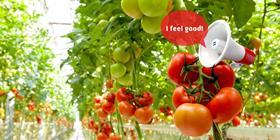
Think of innovation in glasshouses, and ventilation systems, vertical farms and fluorescent pink LEDs might spring to mind. But speak to some of the big players in the glasshouse game, and they will tell you that new thinking, rather than new equipment, holds the key to future success.
Next Generation Growing (NGG), a term coined in the Netherlands, is “a new way of growing where you put the plant at the centre of things and look at plant physics to control the greenhouse,” says Dutch automation firm Hoogendoorn’s Bert-Jan Nolden. The concept uses existing growing equipment in new ways to improve production. And according to AHDB’s GrowSave project, which gives growers information on how to save energy at commercial nurseries, NGG “turns much of the previous thinking about humidity control, the use of screens and venting on its head”.
It’s not so much about investing millions of pounds in state-of-the-art growing systems, but rather understanding the plant’s physics and adapting techniques to improve quality and yield – while saving energy through more efficient production. Above all else, growers must listen to their plants.
Hoogendoorn recently launched a new product called PlantVoice, a control system that allows growers to keep a plant’s energy, water and assimilates levels “in balance” by monitoring its condition. Producers can then adapt the irrigation cycle and glasshouse climate to match the crop’s needs.
At this summer’s GreenTech trade fair for horticulture technology, the firm also launched Connected Screening – software that connects Hoogendoorn’s iSii process computer with glasshouse climate screens to give growers full control over humidity transfer and light transmission, as well as delivering energy savings.
Field research in line with the NGG philosophy has shown that the highest crop yields can be achieved under double-layer energy screens and completely closed screens, so the aim of the Connected Screening system, says Nolden, is “to keep the screens closed as much as possible”.
The software calculates the effect that the screens’ positioning has on ventilation, humidity transfer, energy savings, and the transmission of light and radiation. Using this data, growers can then adjust their screen accordingly and keep them closed for as long as possible, while still keeping down humidity levels.
In addition to these new control systems, progress is being made in LED lighting – an energy-efficient alternative to sodium lighting systems, which has the potential to save money and boost yields. In September, Philips Lighting announced that both APS Salads, which last year became the UK’s largest tomato grower after its acquisition of Wight Salads, and tomato supplier Flavourfresh have improved fruit quality and trimmed their energy bills since completing their first growing cycles with Philips LED lighting.
“After 12 months with 100 per cent LED, we are growing consistent-quality tomatoes right through the winter that taste as good as mid-summer ones,” says APS Salads’ group development director Phil Pearson. “Furthermore, we are using two-thirds less power compared to when we were running HPS (high pressure sodium)-lit greenhouses.”
But, so far, British growers have been slow to invest in LEDs. The cost of installation remains prohibitive to many, and they only become profitable – through increased yields and energy savings – when used on a large scale. The technology is still in its early stages, with few proven trials to date.
“Nobody seems to be able to work out whether they make a difference or not,” says Lee Stiles of Lea Valley Growers. Producers in the trade body are currently trialling different colours and light differentials, which, according to Nottingham University crop scientist Erik Murchie, can be used to regulate a plant’s form and structure.
Another major challenge for glasshouse growers lies in addressing seasonal labour constraints – an issue that has been given added importance by the UK’s EU exit. Thanet Earth, which is in the final stages of building a fifth greenhouse spanning 6.35 hectares, has been asked to participate in a research project aimed at developing a cost-effective robotic system for crop inspection and automated harvesting.
The project, led by Sharp Laboratories of Europe, will bring together knowledge of robotic arms, 3D sensing, computer vision and object/pattern recognition, as well as expert industry knowledge of optimum growing and harvesting practices. “There’s still a way to go with robotics,” says Thanet Earth managing director Des Kingsley. “But it’s really interesting to see the potential at first hand. Its long-term potential remains to be seen, but we have to be part of the future.”
More generally, Kingsley believes there is “clear need” for more glass in the UK – especially given the strong demand for British produce. But there is “a complex web of reasons why we aren’t seeing faster progress towards more glass,” he says. An increasingly commoditised marketplace means that only the largest, most efficient producers will be able to trade profitably using glass; and a lack of available land, combined with hostile planning authorities and neighbours, have presented businesses with further barriers to construction.
It also remains to be seen how further investments in glass will be funded given the devaluation of the pound and the fact that many of the construction materials are imported from the Netherlands. But if the proponents of NGG are to be believed, it is new thinking rather than expensive new equipment that really matters.






No comments yet